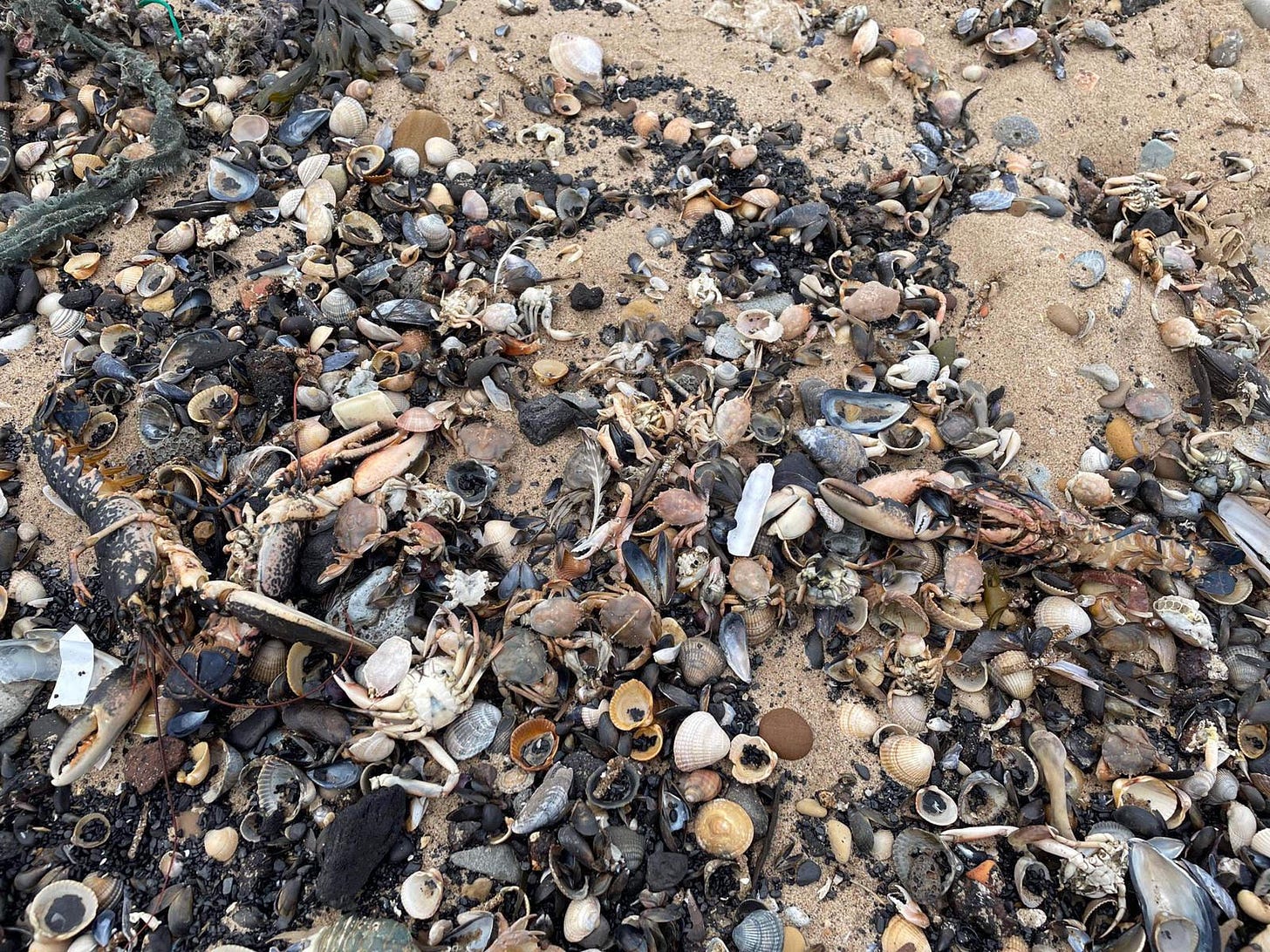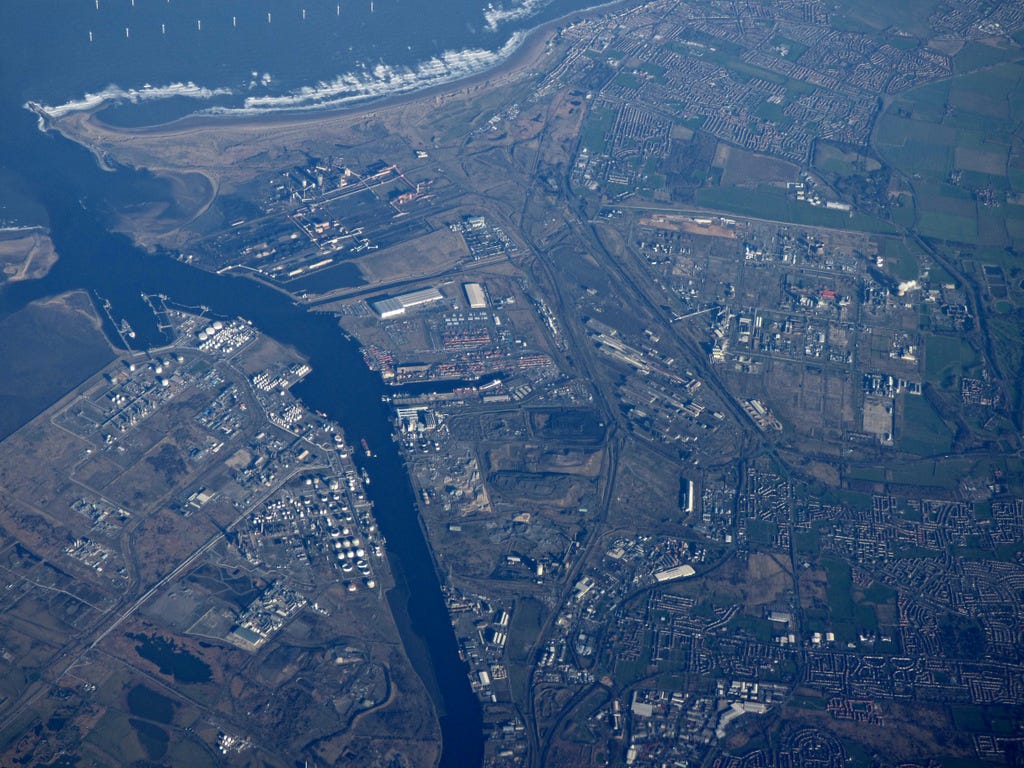Outsiders encounter Teesside the same way
PLUS: What killed all the crabs in Teesside? The Teesside Lead returns to the topic of its very first edition
Hello and welcome to The Teesside Lead.
The great Leigh Jones is having a well-earned holiday for today’s edition. In his place, writer for hire Richard Smyth has been commissioned to write about Teesside for something completely different for readers.
Smyth writes features for The Guardian, BBC Wildlife, The New Statesman and others but also has his crosswords appear regularly in New Scientist. He’s a cartoonist for Private Eye and the author of five non-diction books. Find out a bit more about Richard here.
We’ve also got an update into the investigation into the mass wash-up of dead crustaceans in the North East. Those with long memories will likely recall this was the subject of the first ever edition of The Teesside Lead.
Kojo Moe on a drive through Teesside
By Richard Smyth
Most outsiders, I suppose, first encounter Teesside the same way: from the A19 flyover, heading north (heading somewhere else), and gaping at the famous Bladerunner skyline. There’s a concept in Japan that they call kojo moe, which I think translates directly as ‘factory love’ – it describes a sort of industrial nostalgia, a taste for leftover hulks, petrochemical infrastructure, ironworks, oilrigs, the great techno-gothic cathedrals of the 20th century. You can’t drive north on the A19, especially at night, when the great skyline flares and steams, without getting a sharp dose of kojo moe. I can’t, anyway.
I’d driven by the skyline a dozen times before I ever took the turn-off east and got a little taste of Teesside proper. The RSPB’s reserve at Saltholme is just a short drive from the Stockton junction, a couple of miles of medium-to-heavy industry, ‘Olympic Tank Wash’, ‘Arrowbuild’, ‘Chemoxy International’, down-at-heel guesthouses whose signs say ‘contractors welcome’, and then all that doesn’t exactly drop away, doesn’t exactly fall silent, but seems at least to fade into the background as Saltholme opens out in front of you. This great sprawl of wetland – itself an industrial relic, dredged over decades for salt and minerals – is now a home to birds including lapwing, dunlin, little ringed plover, golden plover, common tern and avocet (a black and white wader with a retroussé bill, familiar from the RSPB logo). All this bright, busy life in the shadow of Teesside’s great industrial icons, the transporter bridge, the hydraulic clock tower, the power station at Hartlepool.
Head a bit further towards the coast and, at a mini-roundabout, two options present themselves to you. Seal Sands is straight on. ‘Seal Sands’ – a vast chemical complex – is right. On impulse, I went right. You follow purpose-built roads past grim wire fencing and very soon you’re driving through a sprawling iron Byzantium, where seagulls wheel over multiple miles of steampunk pipework, tanks, masts, towers, silos, and only the odd lone van passes you, only the odd solitary guy in a high-viz eating a sausage roll from a bag sees you pull up at the dead-end and gawp and snap a picture of some titanic, steaming steel Thing (because of course part of the strange, painful appeal of these places, to the post-industrial northerner, is not actually knowing what any of these things are or do: where is the Collins pocket field guide to industrial hardware?).
The funny thing is, when you retrace your journey back to the roundabout and hang a right, heading for the actual Seal Sands, expecting a nature reserve, a Site of Special Scientific Interest, a stretch of clear estuary snatched from the maw of the petrochemicals industry – well, you do get that (you get acres of dark sand stalked by curlew and oystercatcher and avocet, and you get grey and common seals ligging out in the sun), but this is Teesside, so you get a lot more besides. You get kojo moe. You get a better view of Hartlepool power station for one thing, out there at the mouth of the river, but best of all you get to see what we might call (with only a little irony) the real flagship of North Sea industry: Shell Brent Charlie.
Shell Brent Charlie, red and rusted, flecked with birdshit, hangs impossibly in the salt-air haze. It – she? – is a North Sea oil platform, active in the oilfields between Shetland and Norway since 1981, but now decommissioned and sawn off at the knees, and being patiently taken apart the sprawling scrapyard of Able Seaton. Machines like Shell Brent Charlie have long afterlives. I think of ‘Oddball’, the hulking BE1150 dragline excavator that still stands at RSPB St Aidan’s in Yorkshire, as big as a row of houses, now home to kestrels and roosting starlings.
At Teesside, where the sea is close enough to taste (though it’s never all you can taste, there in the middle of the North East of England Process Industry Cluster), living industry, working industry, chugs on. But the quiet, managed decay of Shell Brent Charlie reminds you, as you walk the headlands or watch the seals, how it all ends up, one way or another: back where it began, in the sea, and the sand, and the earth.
Investigation into unprecedented wash-up of dead crustaceans in Teesside struggles to get co-operation from government
By Stuart Arnold

A report by councillors into an incident which saw a mass wash-up of dead crustaceans on North-East beaches has criticised a lack of co-operation from Government agencies.
Councillor Philip Thompson, who chaired the working group behind the report, said the significant die-offs first discovered in Redcar and Saltburn in October 2021 had been “unprecedented in its magnitude”.
He said “considerable challenges” had been faced in its investigations, including inadequate engagement and co-operation from public bodies, most notably the Department for Environment, Food and Rural Affairs (Defra).
Cllr Thompson, who represents Saltburn on Redcar and Cleveland Council, said this had hindered meaningful dialogue and claimed replies received had often been “disrespectful” to the local authority efforts.
When contacted for comment, Defra did not respond directly to the criticism, but said it continued to monitor marine life around the coast and was open to further engagement with researchers and the academic community.
The cross-working group, which included councillors from Redcar and Cleveland and Hartlepool councils, as well representatives from Middlesbrough, Stockton and later North Yorkshire County Council, was formed in November 2022 in response to a series of motions tabled across the area by elected members dissatisfied with the Government-led response, and aimed to further explore circumstances surrounding the shellfish deaths.
Its final report calls for a greater awareness of issues impacting fishing and coastal communities and says the impact of the die-offs was “catastrophic” with most areas along the coast in both directions from the mouth of the Tees experiencing a subsequent fall in catches and the livelihoods of many people being permanently altered.
It said response mechanisms needed to be more robust and timelier to address potential similar incidents in the future.
Keep reading with a 7-day free trial
Subscribe to The Teesside Lead to keep reading this post and get 7 days of free access to the full post archives.



